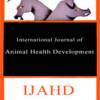Volume 1, Issue 1, 2016

Mcmed International
International Journal of Animal Health Development
Issn
XXX-XXXX (Print),
XXXX-XXXX (Online)
Frequency
bi-annual
Email
editorijahd@mcmed.us












